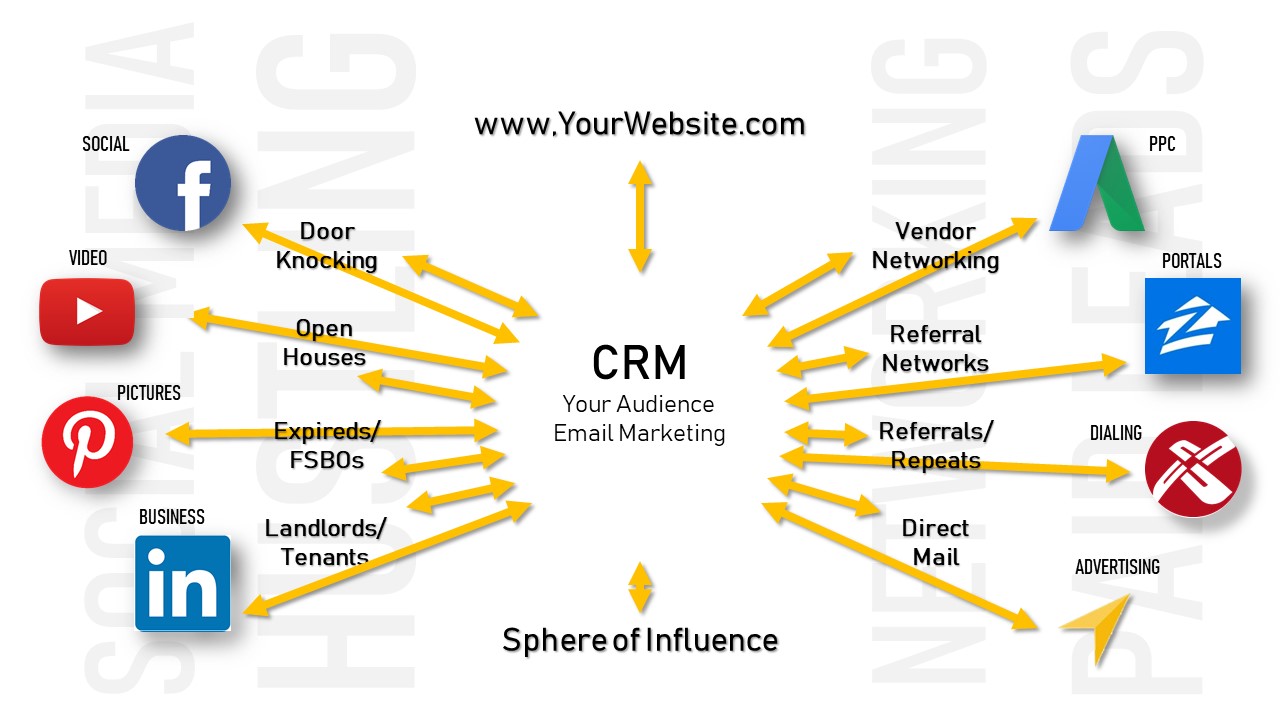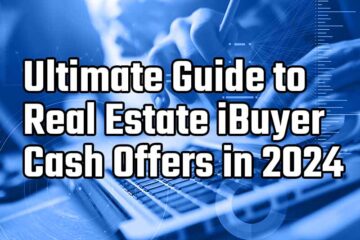Building the Hub and Spoke Model into Your Real Estate Business
I won’t go into the particulars of prospecting in each spoke – that is best left to other articles.
Instead, this article is meant to describe the basic system your business should be operating under and how to connect all your spokes to the hub.
The Model

The hub-and-spoke model is named because of how it looks very much like a wheel. The wheel hub in the center of your business is your business core. The spokes are pieces of your business that feed and support the core, but are not themselves the core of your business.
If you lose a spoke, your business will still keep turning, supported by the hub and the other spokes. But you can’t lose the hub or everything falls apart.
The only purpose of every spoke is to feed your hub, the CRM.
This means a couple things. First – building a spoke for its own sake is a waste of your time. Getting lots of likes on your Facebook page is worthless if it isn’t translating into names, emails, and phone numbers. Knocking doors is worthless if you are not adding the people you meet into follow up campaigns. Paying for Zillow leads is worthless if you are not reaching out to them to build and nurture your relationships.
Why Hub and Spoke?
If you were to sell your business today, what could you sell? Your YouTube channel? Your list of FSBOs? Your paid Zillow leads?
No. You don’t own your YouTube channel. You don’t own a list of FSBOs. You don’t own your Zillow leads.
There is only one thing you actually own that you can sell: Your database.
That is why your database (i.e. CRM) should be at the center of your business. Facebook can change the rules and wipe your Facebook page off the planet. Google can stop ranking your website. Zillow can stop selling you leads.
Nobody can take away your list of names, emails, and phone numbers. Nobody can get in between you and your direct relationships. For that reason, relationships – your database – should be the core of your business.
The Hub
Some models show your own website as the hub of your business. This is a mistake. Your website, while important, is just another spoke that feeds your real business, which is relationships. You can live without a website. There are still many agents who do just fine with a website that does nothing for them. Your business is your relationships with clients, leads, and prospects.
You will notice in the model that the arrows point both ways. The model is not just about the spokes feeding the hub. The Hub can also feed the spokes, like when you integrate your video content into your drip campaigns, or you point your email list to the latest blog article you wrote, or you specifically use your PPC campaign to target your own email database. You can multi-purpose your content to help each other, as long as the ultimate goal is achieved – your CRM and database are your money maker.
I include “email marketing” and “your audience” as prospecting methods that live within your hub, because you own them – they are not a lead source that is under a third party’s control.
Your hub is your CRM. This can be as simple as an excel sheet with names, numbers, and emails. But most likely, it is on a real estate CRM solution that you’ve chosen.
The Spokes
I’ve grouped the spokes into a few broad categories, though this is still only a fraction of the different lead sources that you might be using.
The strategies for implementing these lead generation techniques are for a different article. Instead, I am focused here on ensuring that the leads you are generating are getting to your hub – the CRM.
Social Media
- Snapchat
- YouTube
This is one of the easier spokes to get lost on “vanity metrics” that make you feel good about your business but don’t actually mean anything. The number of Twitter followers, or Facebook page likes, for example. These are not unimportant numbers. But getting likes and followers is building your business in your spoke, not your hub. Your goal should be turning likes and followers into names, emails, and phone numbers.
That means using Facebook Lead Ads to capture information. Link Pinterest posts to landing pages. Include call-to-action buttons in your YouTube videos that go to landing pages. Many CRMs may have natural integrations with these social media sites, or you can use landing pages to make it work.
Hustling
- Door Knocking
- Open Houses
- Expireds / FSBOs
- Landlords
Maybe you’re a newer agent without a lot to invest into marketing, so instead you invest yourself! That means you’ve got to hustle!
If you are buying expired or FSBO leads from sources like RedX or Landvoice, then the lead is right there – you bought it. Start working it!
But in other cases, it can be easy to spin your wheels doing door knocking or open houses without capturing that lead and making sure they make it to your database.
When doing door knocking, make it really easy for residents to submit their information with one of the many door-knocking apps out there, including KnockWise and Spotio. You can use a lead magnet to get their info like offering them a market analysis on their home. The vast majority of door knocking leads are not folks looking to buy or sell any time soon, so it is extra important to get them into your CRM so that you can consistently keep in touch with them so that they turn into a deal 1, 2, 3 or more years down the road.
There are several software options to help capture leads and import them directly to your database during open houses. OpenHomePro is one option if you have a computer or tablet that your open house visitors can sign in on. Some CRMs like Wise Agent also have easy landing pages that can double as open house sign-in sheets, directly into your CRM.
Offering a prize is the easiest way to induce visitors to submit their contact information.
Open houses are a prime time to door knock, too. Look at the door knocking advice for how to make the most of that experience as well.
Laslty, don’t forget to follow up with landlords. Especially a listing that failed to sell and the seller ends up renting. It is really easy to forget these folks an, in a couple years, their renter has moved out and they are listing with another agent. Instead, be sure you have a campaign in your CRM for any landlords you know, so that you are available to them when their renter finally moves on and they are ready to sell again.
Networking
- Vendor Networking
- Referral Networking
- Referrals / Repeats
This is closely related to hustling, as it is mostly free!
But it might also be the easiest for agents to forget to integrate into their CRM. Sure, you may have the phone numbers for your past clients and vendors you work closely with, but if they are not in your CRM with regular outreach, then you aren’t getting what you probably should be. How painful is it when you see a buyer with whom you got along great end up listing their home with another agent a few years after you worked with them?
Take some time to deliberately get these folks into your CRM and on an action plan. Reach out monthly to your top 50 in your sphere. Do a weekly lunch with your top vendors. Stay in touch with past clients with market updates while asking for referrals.
Paid Leads
- Facebook ads
- Google Adwords
- Managed PPC Services
- Zillow
- Realtor.com
- Adwerx
- Billboards
- Newspapers
- BoldLeads
I think the goal of any real estate agent should be to generate your own leads instead of pay for them. But there is no denying that paid leads not only work, but are the favorite lead generation method of many of the country’s top brokers.
PPC (pay-per-click) campaigns (Facebook Lead Ads, Google AdWords, Bing) usually drive traffic to a landing page tailor-made for the keywords targeted. The landing page captures their information and should feed it to your CRM for your follow up.
PPC is one of the most expensive methods of lead generation, and very competitive. It is critical that you follow up swiftly and effectively in order to achieve the margins necessary to sustain a PPC campaign. Many real estate platforms offer their own, managed PPC as an add-on to their services, like BoomTown!, Curaytor, CINC, and Real Geeks.
Buying leads from the portals is another popular paid lead sources for Realtors. In these cases, many portals send leads to multiple agents, so not only do you want to send these leads to your CRM for a quick follow up, you might also want to check out what a company like Agentology has to offer, following up with the leads promptly for you.
Many CRMs have a direct integration with the real estate portals to make following up with these leads as seamless as possible when you get a new one, though some might have it exclusively through Zapier.
General advertising fits in here, though general advertising can be difficult evaluate your return on investment. Being all over the place and “top-of-mind” certainly has benefits, but isn’t the same as having a phone number and email for a prospective client that you can reach out to.
Connecting Spoke to Hub
The biggest mistake is spending time building your spokes but leaving it unconnected to your hub. That could include getting Facebook page likes, but not emails. Maybe you throw a wicked open house, but don’t get your attendees into your database. Maybe you’re a local old-timer, bumping into friends and acquaintances left and right, but without ever entering your sphere of influence into your database where you can strategically keep in touch.
Some of the spokes integrate fairly well with your CRM. Your website, dialer, or paid leads service might be part of your CRM.
Others might not be as obvious. How do you turn fans on Pinterest into names, emails, and phone numbers?
Lead Magnets
Promote something of value.
This applies to every spoke. Door knocking? Do more than just ask people if they know anyone thinking about selling. Offer something of value that requires them to give a little information. For example, you could offer to email them an evaluation of their tax assessment to consider whether it’s worth appealing. Lower taxes? Sure! My name is Brian and my email is [email protected]!
Online lead magnets are things like buyer guides, or even your IDX. There are different views on forced registration, but the listings people can search on your website is a form of lead magnet.
Landing Pages
Closely related to lead magnets is landing pages, also known as squeeze pages. These are bare-bones pages that focus on one thing and one thing only: driving action. That action is usually purchasing a product or, in our case, submitting their name, email, and phone.
Unlike normal web pages on your site, landing pages do not have a lot of outbound links, menus, advertisements, sidebars, or distractions. There is sometimes literally only one link on the entire page – the “call to action” button leaving visitors no choice to proceed but to submit their information.
Included on the landing page is additional information to sell the visitor on the decision to click through and submit their personal information. Social proof, product information, a sample, the pain points solved, and more.
The most common real estate style landing page could be a “what’s my home worth?” page. You can use nearly any of the digital spokes above to drive visitors to this landing page. Share a relevant picture on Pinterest that links to your landing page. Promote this link on Facebook or pin the post.
The goal is to turn an audience into contact information.
Integrations
Many of the spokes above have direct integrations to your CRM, depending on the CRM you choose.
But many CRMs also play well with third-party integration services like Zapier.
Spending some time up from to make sure all your lead sources are connected to your CRM and sent to action plans when they sign up is a highly worthwhile use of your time.
A visitor may have been reading your blog for months, or followed you on Twitter, or been getting your neighborhood updates in the mail for years. But this is now their first direct interaction with you and your brand, and the most critical time when they are still considering whom to use for their real estate services.
It deserves another article on how to set up autoresponders, integrate video, and tailor your follow up plan to each lead for maximum effect. But make sure that all your leads from all your lead sources are connected so that you keep your pipeline full.
Conclusion
The key is getting your leads into your CRM, no matter where they are coming from. Your CRM is your business!
If you have a lead generation tool that does not have a direct integration with your CRM, consider something like Zapier. Zapier works with numerous different tools and, once setup, can send all your leads directly into your CRM for dozens or even hundreds of different sources.
That is how you build a business that doesn’t depend on the latest social media fad or search engine algorithm. Instead, you can swap out old spokes for new ones, see what works and what doesn’t, all while focused on growing and nurturing the core of your business – your database!


